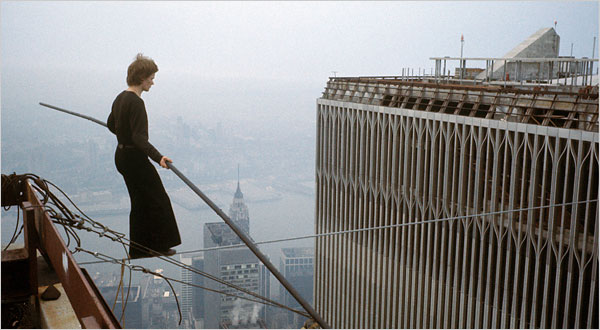Director: James Marsh,
Watched in: Theater,
Rating: 4/5.
Man on Wire contains the suspense of a whodunit, the tension of a heist film, and the poetry of a ballet. It tells the story of Phillipe Petit, a Frenchman who could be the greatest high wire walker of all time. But this is no biography, or hagiography, and there is no built-in competition to provide us with a formulaic climax. Petit’s only competition is with his own notion of failure.
As a young man he followed the construction of the Twin Towers in Manhattan, and decided that yes, in 1974, walking a wire strung between them needed to be done, and he needed to do it. Man on Wire breaks this goal down into segments that form the film’s narrative structure: the dream, the preparation, the set-up, the accomplices, the night before, the morning of. One of the most enjoyable aspects of this entertaining film is its breezy asides and delightful detours, the minor character with nicknames and their lets-put-on-a-show approach. Petit and his team were the merry pranksters of vertigo.
Director James Marsh has a great eye and a fine sense of how to apply cinematic techniques to documentary filmmaking. First off, he’s lucky that many of those involved in Petit’s wire walk are still alive and willing to talk; and that there is archival film, still photos, local news clips, and stock footage to work with. But Marsh also uses recreations, shot in a noirish, grainy black-and-white, that helps to ratchet up the sense that you are witness to a thrilling crime-in-progress. This movie is so fast paced and edge of your seat engrossing you may forget to breathe. You won’t forget to laugh however.
Petit’s joie de vivre is infectious. He frequently leaps out of his chair to pantomime recreations or construct little models to illustrate the scene of the crime. The New York insiders he enlisted in his scheme are like character actors in a Sidney Lumet picture; more than willing to be belittled for their cowardice or to take credit for knowing when to quit. And the reaction of the witnesses, including the cop who had the assignment of arresting Petit when he came off the wire, suggest a more forgiving, more joyous America, when mavericks and dreamers could pull off stunts like this, engage a willing nation’s playfulness, and get off with a wink and a slap on the hand.
Remember here that Petit, working without a net or safety wires, was courting death. His feat is a great leap of faith, not only in the unpredictability of wind and weather, but also in humanity. His walk in the sky was a celebration of the spirit that allows tall buildings to be built and the forgiveness of his fellow man. The image of the lanky Frenchman, 1300 feet in the air, dancing between the tops of two buildings that were, 27 years later, brought down by the forces of hate and intolerance, is one of the more potent images in recent cinema. It may even bring a lump to your throat.

